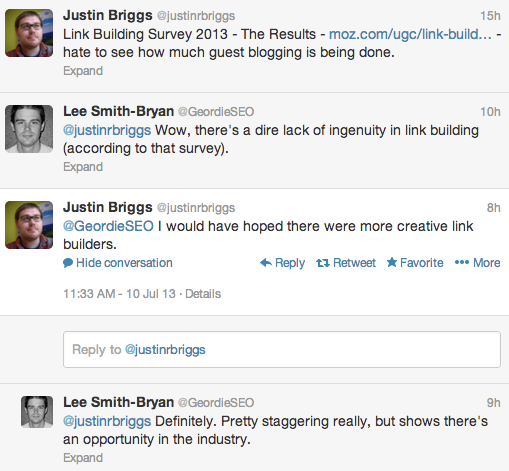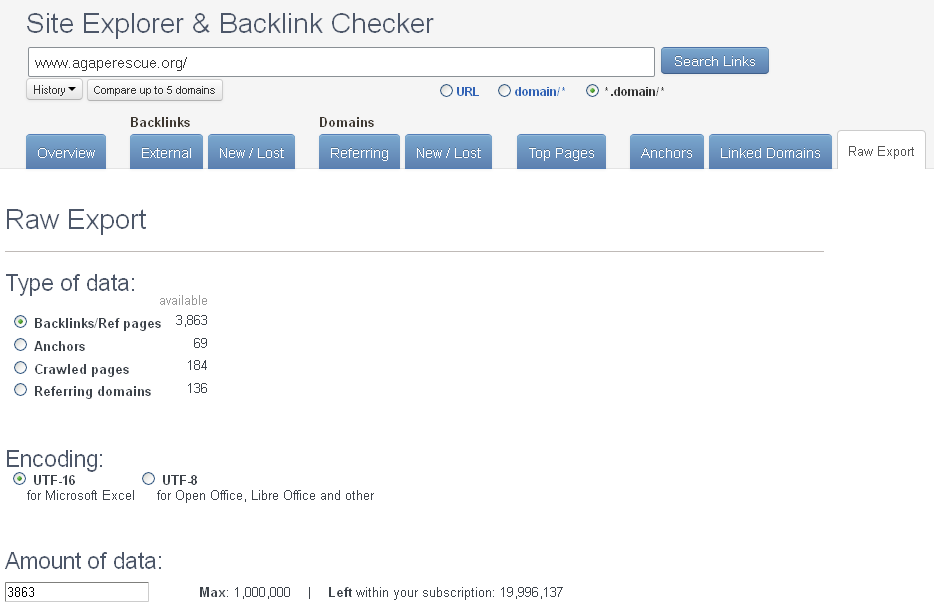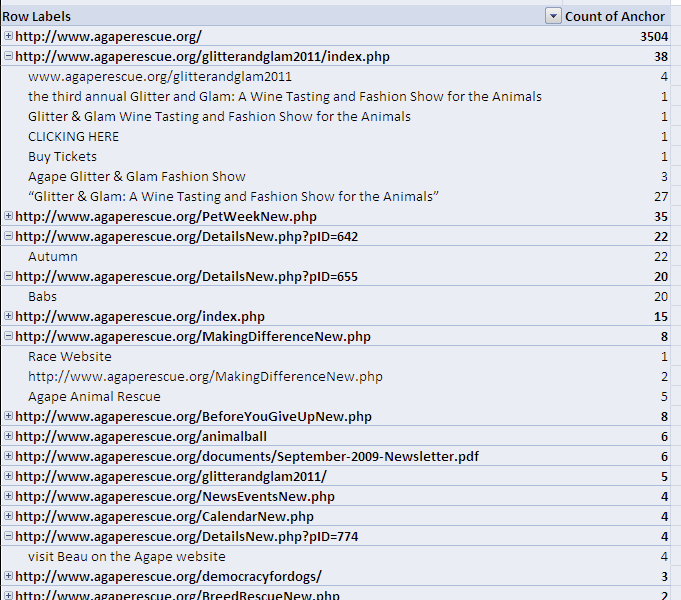A post on the Moz blog a few weeks ago, Link Building Survey 2013 – The Results, divulged some interesting information on the topic of link building. I say ‘interesting’ because the survey results reveal some startling insights regarding our industry, or the subset of link builders within it (that took the survey). The survey was created by SkyRocket, and featured participants between 12th June – 19th June, with a total of 383 participants.
The first doubt I have with the survey is the participant percentage. According the the blog post, 42% of participants were actual link builders, 27% were team managers, and 31% were executives or agency owners. How can executives or agency owners give an accurate response regarding link building? Unless, these executives or agency owners run a small shop, then I could understand, but the connotation of executives or agency owners can perhaps give the mistaken representation of a large agency vs. a one or two man operation.
Without going into the full scope of the post, here are some of the other notable items:
- The survey participants found that the three biggest challenges regarding link building were finding link prospects, creating efficient processes, and getting link prospects to respond.
- Some common forms of link building include guest blogging, content marketing initiatives, resource page link building, digital PR, and paid links.
- Most effective link building tactics include broken link building, guest blogging, and infographic placements.
- Least effective link building tactics include directory submission, article marketing, and link exchanges.
- Survey participants indicated that the next 12 months for link building would see them employ the tactics of guest blogging, digital PR, and content marketing campaigns
My first impression after reading the survey was that our industry seems to lack any kind of creative link building movement. There doesn’t appear to be much ingenuity in these survey results at all (although this could be indicative of the survey participants more than anything else). Apparently I wasn’t the only one who had this impression:
A Better way to Build Links
What if I was to say that there’s a better, data driven way to build links? I think some of the link building methods mentioned in the survey are legitimate (such as capturing the low hanging fruit), but expecting to get stellar links from these same methods over and over again will prove unfruitful. I love the quote from Albert Einstein:
Insanity: doing the same thing over and over again and expecting different results.
As well as using the more mundane methods to build links, how about we utilize a combination of the aforementioned low hanging fruit, as well as backlink analysis with genuine human interest. Data + humans = WIN!
I’m going to choose a local Nashville charity, the Agape Animal Rescue, and walk through some of the ways I would go about building links for their website if I were working on their link building campaign.
Tools I Use when Building Links
I like to use multiple data sources and tools when doing link research. I don’t like to rely on just one data sample, and since MajesticSEO is within RavenTools, I will already have what I need. I will also use ahrefs as another data source for links. If I were to have access to the client’s GA and GWT data I would include these, but as a point of reference, a link building campaign can be created and executed without the need of of Google intrinsic tools, but would most definitely be utilized to measure the results of the work involved.
Of course, there’s some Excel wrangling to be had as well. You thought you could get away without using Excel didn’t you? Sorry, but:
The Process
(Note: the process assumes that no disavowing of links need to be done)
I’m not going to go into the initial phase of the process, but generally I like to make sure that all of the on-site optimization is buttoned up, prior to link building. There’s nothing that frustrates me more than wasting page authority through sub-standard on-site SEO. I would generally do this by:
- Analyzing GWT Data: Look at crawl errors, query reports, robots.txt, duplicate content (as well as www and non-www issues), duplicate titles & descriptions, and internal links
- Making sure that links already acquired don’t 404
- Run ScreamingFrog through the site and eliminate any anomolies (404s, 301s, duplicate content, canonicals, and more)
- Use Raven’s site auditor and fix the issues
Depending on the condition of the site, the above could take a fair amount of time to go through, but if we’re talking about an effective link building campaign, the pages we drive links to need to be in an acceptable condition.
The first step in the link building process is get both a fresh and historical look at the links. Historically speaking, I want to know about any kind of link building that’s been done before, and, if it’s been successful, can we scale it?
Head on over to Raven, go to Links > Backlinks and pull a historical backlink analysis. Hit Explore.
Once you receive the results, you need to export that into CSV using Raven’s exporter.
What I do now is strip out the columns I don’t need, so in this instance, I’m going to take out the f0llowing columns:
- AC Rank
- Date
- NF
- IMG
I removed these four because they really don’t tell me much about user intent. That leaves me with Source URL and Anchor text. From these two columns, you’re going to create a simple pivot table that sorts the most popular anchor text to the least popular, with a column for the total count (by the way, if you want more Excel goodness, check out Excel for SEOs by Distilled). So you should end up with something that looks a little similar to this:
The above is just a partial screengrab of the list I ended up with, but it’s pretty clear that there are some emerging trends from just this list alone. The first trend being that the wine tasting and fashion show seemed to grab a lot of interest (who doesn’t love a wine tasting and fashion show event?). The second trend being that there are some one-word name anchor text links that are animals which were profiled for adoption.
A link building campaign could be crafted from just the above, but I’m going to take it even further. I want to know what the actual content was, and why it was so compelling that people wanted to link to it. For this, I’m going to use ahrefs.
You’ll need a professional account with ahrefs because you need to do a raw sort. On the export screen this is what I have:
With this export you’re going to get everything. What I’m most interested in is the URLFrom, and Anchor text columns. In the pivot table you need to make, basically what you’re going to know is which URLs on the site are attracting what kind of anchor text, and how many. You’re going to sort this list by the Count of Anchor column, from highest to lowest. Since ahrefs gives us the breakdown by URL we can instantly know what pieces of content are attracting the most links, and which anchor text is being used. Here’s an example of part of the list from the pivot table I created:
This pivot table confirms what our export from Majestic (via Raven) told us, but now we can inspect the content on a more granular level. Upon close inspection, some of these dynamic urls that appeared to be used for individual animal profiles contained no content. I would look to put content on these pages saying that the animal had already been adopted, or 301 this to another similar animal (dog type and breed would be a great choice here, or even redirecting to the type of animal rescue page).
It’s clear that links to AgapeRescue were generated from:
- Profiles of animals up for adoption
- Events
- Documents of interest
Those are three items that can be used as a foundation to begin your content strategy.
The beauty of this process is that even if you have a relatively new site that hasn’t yet acquired a large number of links, then you can use this example on a competitor’s site to give you an advantage in devising your initial 12 months of content.
Conclusion and Scalability
This concept, built on human nature rather than relying on crappy, stale link building techniques that run the risk of penalization, ensures that you’ll never run out of content generation ideas because they each share a common element – people want to link to them. However, this is just one part of the process.
To form a much more holistic idea of popular content, you’d also run a similar process like this but through social channels. Find out which content was tweeted, pinned, favorited, shared, and stumbled and scale that out as well. Between the two strategies, content generation shouldn’t be a problem, and neither should fearing a penalty from Google.
In his Mozcon presentation from 2012, Will Reynolds has a quote in slide 112 that really stands out:
Search strategy should be driving content strategy
I couldn’t agree more.

Lee Smith
Nashville SEO Consultant
Lee is an experienced Search Engine Optimization professional having 15+ years of experience and creates content to help website owners succeed with SEO and WordPress.





